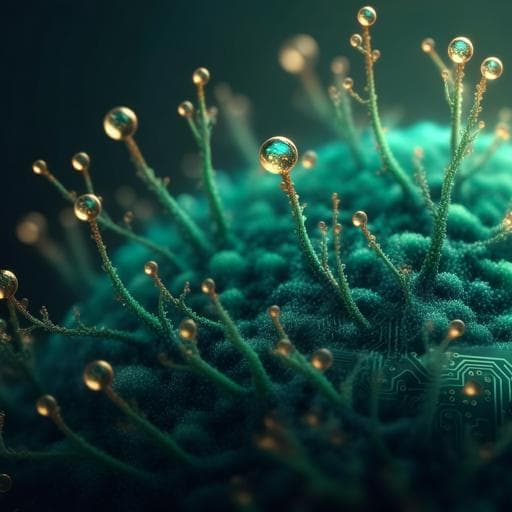
Engineering and Technology
A nanoforest-based humidity sensor for respiration monitoring
G. Chen, R. Guan, et al.
Discover the groundbreaking triple-layer humidity sensor developed by a research team led by Guidong Chen and colleagues! This innovative sensor offers exceptional sensitivity and rapid recovery time, making it a game changer for respiration monitoring in consumer electronics and medical applications.
~3 min • Beginner • English
Introduction
The study addresses the need for compact, accurate, and fast humidity sensors for respiration monitoring. Conventional sensors often suffer from large size, low sensitivity, parasitic capacitance, temperature drift, and slow recovery, especially under high humidity where condensation delays desorption. While various MEMS humidity sensing principles exist (resistive, optical, resonant, capacitive), capacitive sensors balance accuracy and integration but are limited by humidity-sensitive materials and substrate-induced parasitics. Polyimide (PI) sensors, though CMOS-compatible, offer low output swings (~1–2 pF) requiring costly ASICs; porous silicon and ceramic-based sensors provide higher sensitivity but have complex, non-CMOS-compatible processes. Parasitic capacitance through SiO2 and Si substrates degrades accuracy, and temperature changes alter the dielectric constant of sensing layers, introducing drift. The research question is how to design a CMOS-compatible capacitive humidity sensor that simultaneously increases sensitivity, eliminates parasitic effects, compensates temperature drift, and accelerates recovery for reliable respiration monitoring. The proposed solution is a triple-layer architecture integrating a nanoforest-based sensing capacitor, a matched-structure reference capacitor, an on-chip microheater, and a thermistor to address these challenges.
Literature Review
- Capacitive humidity sensors with IDEs coated by materials such as porous silicon, ceramics, and organic polymers (e.g., PI) are widely used, but each has trade-offs: PI is CMOS-compatible yet yields small capacitance changes (~1–2 pF), necessitating high-precision ASICs; porous silicon and anodic aluminum oxide offer higher hygroscopicity and sensitivity but rely on complex, less CMOS-compatible fabrication.
- Substrate parasitics (electric field lines penetrating SiO2 and Si) distort true sensing capacitance, limiting sensitivity and accuracy, as previously reported (e.g., Gerwen's work on parasitics through substrates).
- Temperature dependence of dielectric properties in humidity-sensitive films induces drift, and water condensation at high RH leads to long recovery times.
- Prior sensor modalities: resistive devices are simple and low-cost but exhibit poorer anti-jamming and accuracy; optical sensors are accurate but face integration challenges with IC processes. Capacitive devices are favored for broad RH accuracy and integration but need improved materials and architectures to mitigate parasitics and drift.
Methodology
Device architecture and operating principle:
- Triple-layer design comprising: top layer with two IDE-based capacitors (sensing capacitor coated with nanoforest and a matched-geometry reference capacitor with Si3N4 dielectric), an intermediate SiO2 insulation layer, and a bottom layer with a serpentine microheater and a serpentine thermistor (R1). A ground electrode is included for EMI suppression; electrodes are roughened for robust wire bonding.
- Differential readout to cancel parasitics: CN = CH − CR, where CH = CNF + CP1 + CP2 and CR = CSi3N4 + CP1 + CP2. Because the parasitic components CP1 and CP2 (through Si and SiO2) are common-mode, they cancel in the differential, isolating the humidity-sensitive nanoforest capacitance CNF.
- The thermistor provides temperature measurement for drift calibration and microheater monitoring; the microheater accelerates desorption to shorten recovery time.
Theoretical background (conventional vs proposed):
- Conventional PI-based sensor total capacitance: CT = CPI + CSiO2 + CSi, where CPI depends on PI dielectric constant varying with RH (via mixing relation and absorption model). Parasitic capacitances through SiO2 and Si bias measurements and limit sensitivity.
- Proposed differential scheme eliminates substrate parasitics and allows baseline adjustment by tuning the reference capacitor geometry.
Fabrication process (CMOS-compatible):
1) Deposit SiO2 on Si substrate.
2) Sputter and pattern 0.4 µm Al to form the serpentine microheater, thermistor, and ground electrodes.
3) Deposit 2 µm SiO2 insulation and open contact vias.
4) Sputter and pattern 2 µm Al to form IDEs and top electrodes; connect to ground via contacts.
5) Deposit and pattern 2 µm Si3N4 on one IDE set to form the reference capacitor.
6) Spin coat ~8 µm PI onto the other IDE set and pattern.
7) Form nanoforests by O2 plasma RIE of the PI: RF power 200 W, O2 flow 50 sccm, 30 min.
Structural and dimensional details:
- Overall die area of sensor: ~1100 µm x 890 µm.
- Active areas: nanoforest and Si3N4 reference each 430 µm x 820 µm.
- Nanoforest height ~4 µm (superhydrophilic; contact angle ~1 degree).
- Microheater line width ~4 µm; thermistor shares identical serpentine geometry.
- IDE variations (samples): Sample-1 (40 IDE pairs; nanoforest), Sample-2 (30 pairs; nanoforest), Sample-3 (20 pairs; nanoforest), Sample-4 (40 pairs; PI-based control).
Measurement and evaluation:
- Humidity response characterized across 10–90% RH at 20 C unless otherwise noted.
- Differential processing (CN = CH − CR) used; CR verified stable (~3.85 pF) vs RH.
- Dynamic response and repeatability tested via step changes between 10% and 90% RH; extended sweeps performed (10% to 90% and back).
- Temperature dependence assessed by measuring at multiple temperatures with constant RH.
- Recovery acceleration via activating on-chip microheater (recovery time target ~5 s). The thermistor monitors temperature for compensation.
Key Findings
- Sensitivity: Sample-1 (40 IDE pairs, nanoforest) achieved 0.11 pF/%RH over 40–90% RH, approximately 8x higher than the PI-based Sample-4 (0.014 pF/%RH).
- Resolution: 0.72% RH in the 10–40% RH range and 0.075% RH in the 40–90% RH range.
- Reference stability: CR remained approximately constant at ~3.85 pF across RH, validating differential cancellation of parasitics.
- Repeatability and dynamic range: At 10% RH, CN ~1.92 pF; at 90% RH, CN ~8.15 pF, with stable and repeatable response/recovery cycles between these levels.
- Recovery time: Integration of the microheater reduced recovery time to about 5 s (enabling rapid desorption and suitability for rapidly changing humidity environments).
- Temperature behavior: The sensor exhibited a positive temperature coefficient consistent with increased water molecule content at higher temperatures for a given RH; high sensitivity maintained across tested temperatures. The on-chip thermistor enables drift calibration.
- Morphology and wetting: Nanoforest height ~4 µm; contact angle ~1 degree, indicating strong hygroscopicity and rapid adsorption/desorption kinetics contributing to high sensitivity and fast response.
- Device scale and integration: Compact footprint (1100 µm x 890 µm) with CMOS-compatible processes; ground electrode design improves anti-interference.
- Application-level performance: Embedded in an N95 mask, the system distinguished different respiration states with 94% accuracy using machine learning.
- Comparative advantage: Differential architecture cancels substrate SiO2/Si parasitics, enhancing true sensitivity and measurement accuracy versus traditional single-capacitor PI sensors.
Discussion
The proposed triple-layer, differential capacitive architecture directly addresses key limitations of traditional humidity sensors for respiration monitoring. By employing matched-geometry sensing and reference capacitors and computing CN = CH − CR, the design eliminates the major sources of substrate parasitic capacitance, thereby isolating the humidity-dependent contribution and improving sensitivity and accuracy. The nanoforest PI surface, created via O2 plasma etching, provides an open, highly hydrophilic micro/nanostructure that enhances adsorption rates and water uptake, leading to an 8x sensitivity improvement over conventional PI films. The integrated microheater accelerates desorption to achieve fast recovery (~5 s), mitigating the condensation-induced lag at high RH, while the on-chip thermistor enables temperature compensation to control drift and monitor heater operation. Collectively, these features yield a compact, CMOS-compatible sensor with wide-range, high-resolution humidity detection, robust repeatability, and improved anti-jamming characteristics. The successful demonstration of 94% accuracy in classifying respiration states in an N95 mask underscores the device’s practical utility for wearable health monitoring, where rapid dynamics, temperature fluctuations, and interference are prevalent.
Conclusion
This work demonstrates a CMOS-compatible, triple-layer capacitive humidity sensor that integrates a nanoforest-based sensing capacitor, a matched reference capacitor, a microheater, and a thermistor. The differential architecture cancels substrate parasitics, and the nanoforest surface substantially boosts sensitivity, enabling an 8x improvement over conventional PI-based sensors while maintaining excellent repeatability and stability. The integrated heater shortens recovery to ~5 s, and the thermistor supports temperature drift calibration. Embedded in a mask, the sensor supports respiration state recognition with 94% accuracy using machine learning. The design is promising for consumer electronics and intelligent medical instrumentation.
Potential future research directions include: optimizing heater power and thermal management for ultra-low-power wearables; comprehensive temperature-compensation algorithms using the thermistor for various environments; long-term reliability and hysteresis characterization under sweat/condensate exposure; monolithic integration with readout ASICs to exploit increased signal swing; and exploring alternative nanostructured or functionalized hygroscopic coatings to further enhance sensitivity and response speed.
Limitations
Related Publications
Explore these studies to deepen your understanding of the subject.







